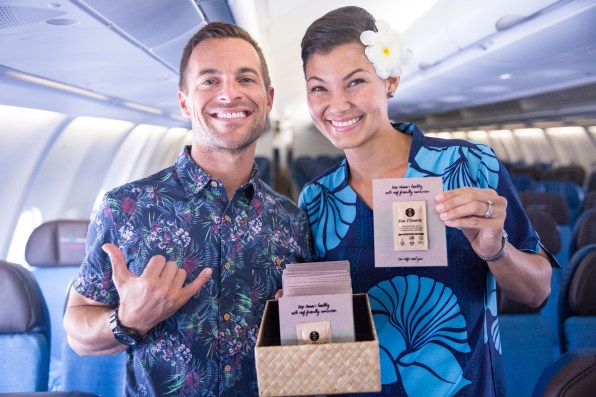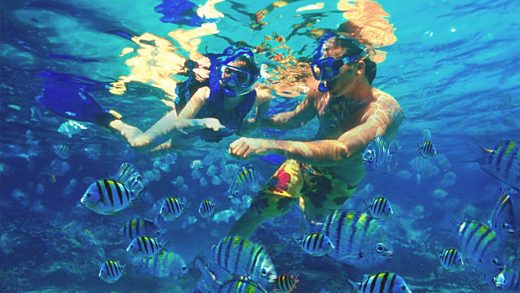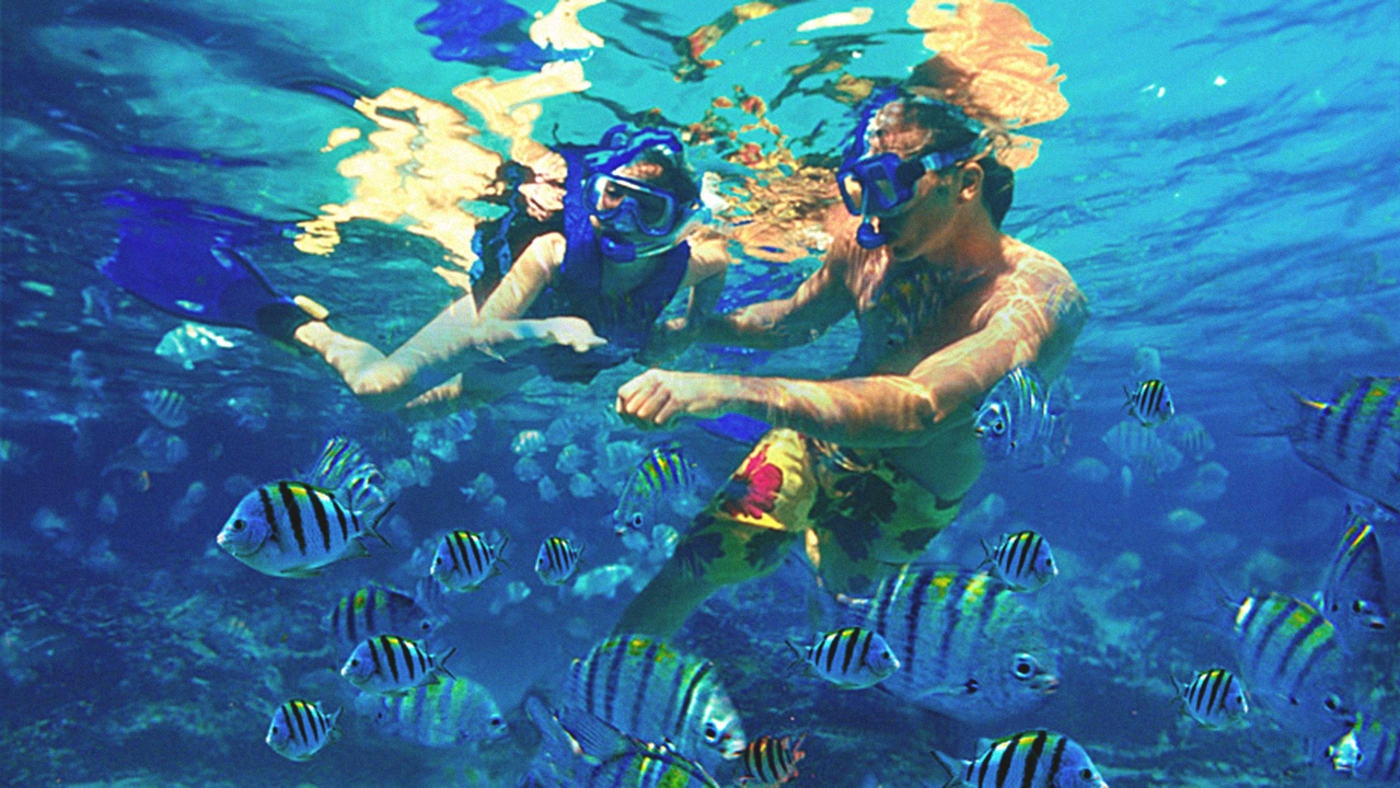Can your sunscreen protect you without killing marine life?
On July 3, Hawaii’s Governor, David Ig, will sign into law the first statewide ban on the sale of sunscreens containing chemicals that scientists say are damaging the Earth’s coral reefs. Passed by state legislators on May 1, the bill targets two chemicals, oxybenzone and octinoxate, which are found in thousands of sunscreens and other skincare products. Studies published over the past 10 years have found that these UV-filtering chemicals–called benzophenones–are highly toxic to juvenile corals and other marine life and contribute to the fatal bleaching of coral reefs (along with global warming and runoff pollutants from land). (A 2008 study by European researchers estimated that 4,000 to 6,000 tons of sunblock accumulates in coral reefs every year.) Also, though both substances are FDA-approved for use in sunscreens, the nonprofit Environmental Working Group notes numerous studies linking oxybenzone to hormone disruption and cell damage that may lead to skin cancer. In its 2018 annual sunscreen guide, the EWG found oxybenzone in two-thirds of the 650 products it reviewed.
The Hawaii ban won’t take effect until January 2021, but it’s already causing a wave of disruption that’s affecting sunscreen manufacturers, retailers, and the medical community.
For starters, several other municipalities have already or could soon join Hawaii’s effort. In May, the Caribbean island of Bonaire announced a ban on chemicals sunscreens, and nonprofits such as the Sierra Club and Surfrider Foundation, along with dive industry and certain resort groups, are urging legislation to stop sunscreen pollution in California, Colorado, Florida, and the U.S. Virgin Islands. Marine nature reserves in Mexico already prohibit oxybenzone-containing sunscreens, and the U.S. National Park Service website for South Florida, Hawaii, U.S. Virgin Islands, and American Samoa recommends the use of “reef safe” sunscreens, which use natural mineral ingredients–zinc oxide or titanium oxide–to protect skin.
Makers of “eco,” “organic,” and “natural” sunscreens that already meet the new standards are seizing on the news from Hawaii to boost their visibility among the islands’ tourists–and to expand their footprint on the shelves of mainland retailers. This past spring, for example, Miami-based Raw Elements partnered with Hawaiian Airlines, Honolulu’s Waikiki Aquarium, the Aqua-Aston hotel group (Hawaii’s largest), and the Sheraton Maui Resort & Spa to get samples of its reef-safe zinc-oxide-based sunscreens to their guests. “These partnerships have had a tremendous impact raising awareness about this issue,” says founder and CEO Brian Guadagno, who notes that inquiries and sales have increased this year.
“The day the ban was announced, a major retailer called to ask if all our SKUs were reef safe,” says Nova Covington, who founded the 14-year-old organic skincare company Goddess Garden, which sells its regulation-compliant sunscreen at nearly 25,000 retail locations nationwide, including Walmart, CVS, Walgreens, and Whole Foods. In the coming year, she plans to increase the prominence of its “reef safe” messaging through its website, advertising, packaging, and in-store displays.

These manufacturers are even joining forces. Caroline Duell, founder and CEO of Morro Bay, California-based All Good, which has sold organic, reef-safe sunscreens since 2005, created the Safe Sunscreen Council last March. The coalition of small reef-friendly sunscreen makers has committed to using safe ingredients throughout their product lines. (All Good’s sales–under $5 million last year–are growing at about 50% annually, says Duell.)
Major brands, meanwhile, seem split on their response. Some are embracing the new regulation. A spokesperson for Edgewell Personal Care, which owns Banana Boat and Hawaiian Tropic, issued a statement saying that “currently, nearly two-thirds of Banana Boat and Hawaiian Tropic products are made without oxybenzone and octinoxate, and we have introduced both Banana Boat Simply Protect Baby and Kids Sunscreens and Hawaiian Tropic AntiOxidant Plus Sheer Touch and Weightless products, which are made without these ingredients.”
CVS, which already offers an extensive selection of reef-safe brands such as Goddess Garden and Alba Botanicals, says in a statement to Fast Company that it will reformulate all its store-brand suncare products SPF50 and below to eliminate oxybenzone and octinoxate, as “part of our ongoing leadership and commitment to corporate social responsibility and to our company’s purpose of helping people on their path to better health.”
But several of the larger manufacturers urge caution. There is a real danger, they say, in jettisoning these ingredients so quickly.
“Eliminating the use of sunscreen ingredients considered to be safe and effective by the FDA with a long history of use not only restricts consumer choice, but is also at odds with skin cancer prevention efforts […],” says Bayer, owner of the Coppertone brand, in a statement to Fast Company. Bayer disputes the validity of studies used to support the ban, which were published by scientists from U.S. National Oceanic & Atmospheric Administration, the nonprofit Haereticus Environmental Laboratory, Tel Aviv University, the University of Hawaii, and elsewhere. “Oxybenzone in sunscreen has not been scientifically proven to have an effect on the environment. We take this issue seriously and, along with the industry, have supported additional research to confirm that there is no effect.”
Johnson & Johnson, which markets Neutrogena sunscreens, is taking a similar stance, worrying that “the recent efforts in Hawaii to ban sunscreens that contain oxybenzone may actually adversely affect public health,” according to a company spokesperson. “Science shows that sunscreens are a key factor in preventing skin cancer, and our scientific assessment of the lab studies done to date in Hawaii show the methods were questionable and the data insufficient to draw factual conclusions about any impact on coral reefs.”
Terrified (and rightly so) about anything scaring people away from using sunblock, The American Academy of Dermatology, also opposes Hawaii’s ban. Suzanne M. Olbricht, president of the AADA, has issued a statement that the organization “is concerned that the public’s risk of developing skin cancer could increase due to potential new restrictions in Hawaii that impact access to sunscreens with ingredients necessary for broad-spectrum protection, as well as the potential stigma around sunscreen use that could develop as a result of these restrictions.”
The fact is that there are currently a large number of widely available reef-safe products on the market that provide “full spectrum” protection up to SPF50–meaning they protect against both UVB rays that cause sunburns as well as UVA radiation, which causes deeper skin damage. SPFs higher than 50 are largely a marketing gimmick, say advocates of chemical-free products: According to the Environmental Working Group, properly applied SPF 50 sunscreen blocks 98% of UVB rays; SPF 100 blocks 99%. And a sunscreen lotion’s SPF rating has little to do with its ability to shield skin from UVA rays.
“People don’t have to choose between protecting themselves or the reefs,” says Goddess Garden’s Covington, who will be in Hawaii when the governor signs the new ban into law. It’ll be a working vacation–she looks forward to doing extensive field-testing of her sunscreen while enjoying the island’s beaches.
Fast Company , Read Full Story
(28)



